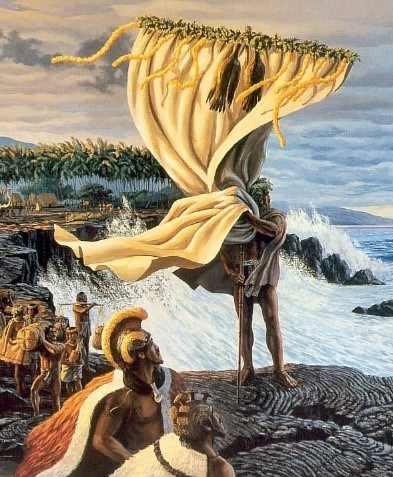
NPS Photo
The Arrival of MakaliʻiAs the Sun makes its southern descent toward Ke Ala Polohiwa ā Kanaloa (the Tropic of Capricorn), practitioners of ka hoʻomana kahiko (traditional religious practice) once again look to observe the signs of Kau Makali‘i – the season of the Makahiki ritual. LonoikamakahikiLono, a deified personification of oxygen and the atmospheric forces of nature, serves to ignite subtle energies within the atmosphere, bringing rains and releasing nutrients necessary to ensure growth and collective abundance. 
Herb Kane Lono MakuaIn the Makahiki ritual an image of Lono, called Akua Loa, traveled a route across the moku (district) in a ritualized survey of the wealth and productivity of the land. A smaller twin image – called Akua Poko – remained within each area for the duration of this observation. Maka WahineAlso called Akua Pā‘ani, this kiʻi (carved image) presided over a tournament dedicated to Lono. Before the Maka Wahine, contestants competed in the sport of Mokomoko (boxing), with each contestant displaying his greatest feats of strength and skill in sight of his ancestors, gods, and people. RejuvenationDuring Kau Makaliʻi Lono is personified, placing an emphasis on creative 
NPS Photo Kau Makaliʻi TodayToday Makahiki is observed as a joyous time where games and competitions take place to celebrate Hawaiian tradition. Wrestling matches and spear throwing draw in crowds and challenge strength and agility. ‘Ulu maika (stone disk rolling) and moa pahe‘e (sliding darts) serve to test skill and accuracy. While kōnane (a strategy game) and ‘ōlelo ho‘onanenane (riddling) strengthen the intellect, with the flawless recital of mo‘okū‘auhau (genealogical chants) being the most impressive and celebrated feat of mind. Lā PāʻaniHere at Puʻuhonua o Hōnaunau National Historical Park, local school children compete in an annual games tournament to celebrate and learn about Hawaiian tradition. 
NPS Photo Cultural IdentityFor Hawaiian cultural practitioners, donning traditional garments perpetuates cultural identity and enables them to engage in native thought and practice. Here, the perpetuation of Makahiki traditions has become an important way local communities commemorate the passage of time and celebrate ancestral wisdom. Across the islands, images of the Lono Makua walk their traditional routes, carried forth by men and women garbed in white, as the ancient prayers are spoken once more.
|
Last updated: November 13, 2021
